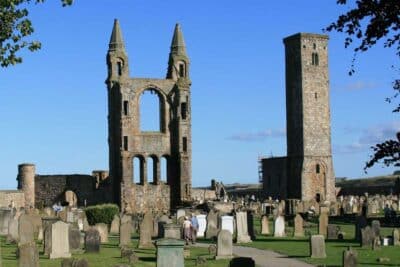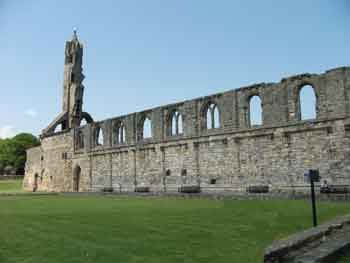In 1309, Robert the Bruce held his first parliament in St Andrews Cathedral.

History of St Andrews Cathedral
According to some of Scotland’s earliest chronicles building by Bishop Arnold on St Andrews Cathedral probably began around 1160.
The cathedral, destined to become the place of worship for many of Scotland’s most important bishops and archbishops took many years to complete.
Nearby is St Andrews Castle the main residence for many of those senior ecclesiastical figures.
Interestingly some of the cathedral’s design characteristics have also been seen in other Scottish monastic buildings, Jedburgh and Arbroath are good examples.
Over the years, large parts of the cathedral either collapsed or were destroyed by fire or English armies.
In 1272 for example the almost complete west front collapsed in a gale, forcing its rebuilding, this time a little further east.
This reduced it to around 460 feet in length, smaller than originally planned. However, even this compared well with York and Durham two of the great cathedrals of England.
Sadly much of the west front was destroyed by fire in 1378 and today only half of one tier of windows survives. In 1409 the south transept collapsed during violent winter storms.
Scottish Wars of Independence
With the bloody Wars of Independence also intervening, it was finally consecrated with great ceremony in the presence of King Robert the Bruce in 1318.
This was four years after his famous victory on the field of Bannockburn.
Bruce who was no stranger to St Andrews had held his first parliament there some nine years before.

St Rule’s Church
Although its origins are still a matter of historical debate there is agreement that St Rule’s Church, which stands in the oldest part of the cathedral complex, was built before the cathedral, probably around 1130.
However apart from its lofty tower (100 feet) little remains of the church which was used as a place of worship for Augustinian canons whose arrival had displaced the Culdees, a Celtic monastic order and nominally part of the Roman church.
St Andrews Cathedral Museum
The St Andrews Cathedral Museum is housed in two restored buildings on the south-east side of the cloisters. They were once the warming house and the undercroft of the refectory.
Inside is a fascinating collection of decorated stonework dating from the Pictish era until after the Scottish Reformation, some as late as the 17th century.
In 1833, small pieces of sculptured stone were found in the cathedral burial ground, they came from a sarcophagus. Today these stones form one of the most exciting exhibits in the museum.
It’s thought that the St Andrews Sarcophagus, as it became known, was a royal burial shrine, perhaps a memorial to Pictish king, Óengus mac Fergusa (died 761).
While acknowledging that the sarcophagus is Pictish, experts have noted the influences from the eastern Mediterranean and the near east.
For example, the intricate detailing on some of the clothes and horse gear is characteristically Pictish.
But the Biblical King David’s clothes are Byzantine in style and his ornate sword scabbard has a contemporary Germanic appearance.
“The figures almost walk off the sculpture in a similar way to east Mediterranean early Christian ivory carvings.”
Anon
These characteristics clearly show that even in the 8th century St Andrews wasn’t isolated but open to artistic influences from Europe and further afield.
Historic Environment Scotland summed up its importance by saying, “Its deeply symbolic design provides an insight into the religious beliefs, political aspirations and extensive international contacts of Pictish kings.”
Scottish Reformation
As the Scottish Reformation gathered pace, John Knox delivered a fiery sermon, on 11 June 1559, at St Andrews parish church.
It so aroused the congregation they immediately went to the nearby cathedral and started to tear down the furnishings associated with ‘Popish’ worship.
Within days there was further destruction, and the friars were forced out.
It meant, like many other religious buildings in Scotland during the Reformation, the complete closure of the cathedral.
Sadly much of the stonework was subsequently pulled down and reused for new building work in the town.
St Andrews Cathedral: Visitor Information
Trains from Edinburgh take around 90 minutes to reach Leuchars, the nearest railway station to St Andrews. It’s around six miles from the town.
While there are local buses the quickest way is by taxi. If you’re driving from Edinburgh it also takes around 90 minutes but during the summer season, parking can be difficult.
For information on opening hours, cost of entry and other tips to help you plan your visit, go to the cathedral website.